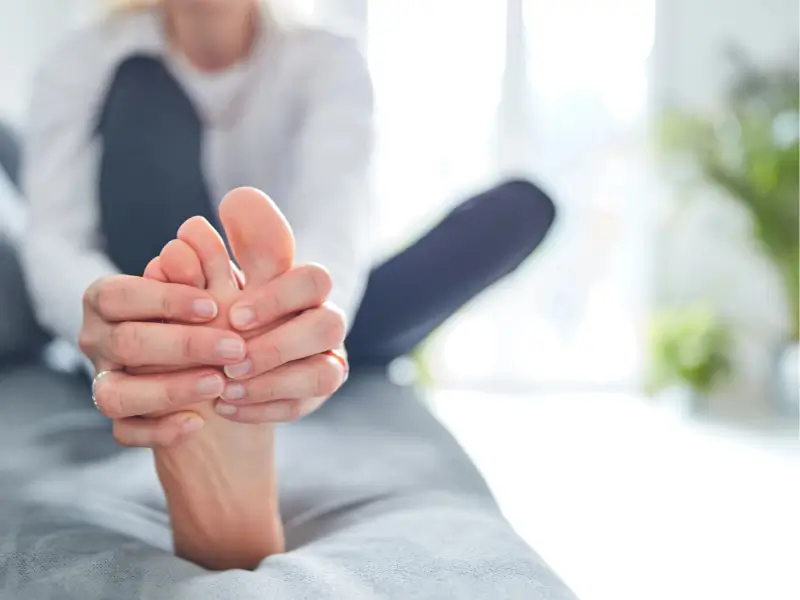Step With Ease
Podiatry

Rated 4.9 stars from 335+ reviews
We’re thrilled to announce receiving hundreds of five-star reviews! While we’d love to share these testimonials, regulations from the Australian Health Practitioner Regulation Agency (AHPRA) prevent us from displaying patient outcomes for regulated services such as Chiropractic, Physiotherapy, Osteopathy, Podiatry, and Acupuncture on this website. To read client feedback, please visit our Google Reviews directly.
accelerate Your Recovery with comprehensive
Podiatry Care!
Personalised Podiatry
More Information Coming Soon!
5-Star Excellence
This collective is proud to showcase hundreds of heartfelt 5-star Google reviews, reflecting the unwavering dedication of practitioners to excellence and patient satisfaction. Each review tells a story of trust, exceptional care, and the meaningful connections individual practitioners have built with those they serve.
Money-Back Guarantee
100% money-back guarantee within 14 days if their service doesn’t meet your expectations, providing peace of mind on your health journey. They only take on cases where they are confident they can make a meaningful difference
Decades of Dedication
Since 1990, this collective has been a cornerstone of the community, earning trust and appreciation while joyfully supporting generations of families.
With over 65,500 patients treated, the journey is rich with stories of care, commitment, and lasting relationships.
Patient-Centric Care
In this cozy and welcoming collective hub, a spirit of inclusivity and vibrancy is celebrated. Here, humility meets excellence, and every moment is devoted to patient-centered care.
Your well-being isn’t just a priority—it’s the foundation of everything, ensuring you feel valued and supported every step of the way.
Compassionate Care
A warm-hearted approach, fueled by genuine passion, is dedicated to making a positive impact on your life.
Care and support are delivered with a commitment to not only meet but exceed expectations, ensuring a nurturing and welcoming experience you’ll truly value.
Podiatry Services
At Brunswick Health, we are proud to provide a space where independent podiatrists deliver high-quality services tailored to the unique needs of our local community. Operating independently means these podiatrists have serious skin in the game—they are not employees, so their success depends entirely on the quality of care they provide. Only the best thrive in this model, as it is driven by natural selection where dedication and excellence are key.
In addition, under the same roof, physiotherapists, chiropractors, and massage therapists also operate as independent contractors. This setup allows for seamless collaboration between practitioners. When needed, they can work together quickly and efficiently without losing the clinical message or diluting important details through unnecessary translation. The result is a more integrated and cohesive approach to your care, ensuring that every aspect of your treatment is optimised.
Our experienced podiatrist, as an independent practitioner, is fully committed to helping you achieve optimal foot health through personalised treatment plans designed specifically for your needs. This independence ensures you receive focused, attentive care because they have a vested interest in your outcomes.
Embark on a journey where every step leads to greater comfort and vitality. In the world of podiatry, the focus goes beyond treating feet—it’s about finding a harmonious, pain-free stride that aligns with your lifestyle.
Welcome to a place where your steps are truly understood, your concerns are addressed with expert precision, and your path to wellness begins with confidence. Let’s step into a future where every journey is effortless, every stride is supported, and only the best podiatry care thrives. Welcome to the art and science of podiatry, where your feet find their best foundation.

Podiatrist ~ Coming Soon!
Podiatry Rehabilitation: Lower Leg Solutions
Shockwave Therapy
Podiatry - FAQs
Browse our general FAQ for quick answers. Didn’t find what you were looking for? Give us a call or send us an email—we’re here to help!
What Conditions Can Podiatry Treat?
Podiatrists are qualified to diagnose and treat a wide array of conditions related to the foot, ankle, and lower extremities. Some common conditions they address include:
- Plantar Fasciitis: Inflammation of the plantar fascia, a ligament that connects the heel to the front of the foot, causing heel pain.
- Bunions: Painful bony bumps that develop on the joint at the base of the big toe.
- Ingrown Toenails: When the edge of a toenail grows into the surrounding skin, leading to pain and possible infection.
- Diabetic Foot Care: Management of foot-related complications in individuals with diabetes, including ulcers and infections due to poor circulation and neuropathy.
- Heel Spurs: Calcium deposits that form on the underside of the heel bone, often associated with plantar fasciitis.
- Athlete’s Foot: A fungal infection that affects the skin on the feet, causing itching, redness, and cracking.
- Flat Feet and High Arches: Structural foot issues that can lead to discomfort and affect walking and posture.
- Arthritis: Inflammation of the joints in the feet, causing pain, swelling, and restricted movement.
- Sports Injuries: Including sprains, strains, and fractures related to physical activities.
- Corns and Calluses: Thickened skin layers that form on the feet due to friction or pressure.
- Hammer Toes: A deformity where a toe is bent at the middle joint.
- Fungal Nail Infections: Fungal growth under the nails, leading to discolouration, thickening, and crumbling.
- Gait Abnormalities: Problems with walking patterns that can lead to discomfort and dysfunction in the feet and lower limbs.
- Morton’s Neuroma: A painful condition involving the thickening of tissue around a nerve leading to the toes.
Podiatrists use various treatments, such as physical therapy, custom-made orthotics, medications, and sometimes minor surgery, to manage and alleviate these conditions, aiming to improve foot health and functionality.
Is Podiatry Treatment Painful?
The answer can vary depending on the type of treatment, the individual’s condition, and their pain tolerance. Many podiatric treatments are non-invasive and focus on relieving pain and discomfort, such as custom orthotics for foot alignment, physical therapy, and medication for inflammation and pain.
For some conditions, particularly those requiring surgical intervention, there may be some discomfort during recovery. Podiatrists are skilled at minimising pain and discomfort, often using local anaesthetics for procedures and prescribing appropriate pain management strategies post-procedure.
If you have specific concerns about pain related to a podiatric condition or treatment, it’s best to discuss these directly with a podiatrist, who can provide information tailored to your situation.
How Many Sessions Will I Need?
The number of sessions you might need with a podiatrist depends on various factors, including the nature and severity of your condition, your body’s response to treatment, and whether you’re undergoing conservative management or surgical intervention. Here’s a general guide:
For Minor Conditions: Issues like mild ingrown toenails, minor fungal infections, or temporary pain might require only one to a few sessions.
Chronic Conditions: Chronic or more complex issues such as plantar fasciitis, bunions, or diabetic foot care often require ongoing management. This could involve regular visits over several months or longer to monitor the condition and adjust treatments as necessary.
Post-Surgical Care: If surgery is involved, you’ll likely need several follow-up appointments to monitor healing, remove stitches, and begin rehabilitation.
Rehabilitation and Physical Therapy: Conditions requiring physical therapy may need multiple sessions spread over weeks or months, tailored to your progress and specific rehabilitation goals.
Each individual’s situation is unique, and a podiatrist will provide a more accurate estimate after assessing your condition. It’s important to discuss your treatment plan and expectations directly with your podiatrist to understand the anticipated course of treatment.
Do I Need a Referral from a Medical Doctor?
Seeing a podiatrist usually doesn’t require a referral since they are primary health practitioners, accredited by the Australian Health Practitioner Regulation Agency (AHPRA) due to their extensive training, which includes a rigorous 5-year university degree.
However, for treatment under Medicare’s Enhanced Primary Care (EPC) program, now commonly known as the Chronic Disease Management (CDM) program, a GP referral is necessary to claim the EPC rebate. This program allows individuals with chronic conditions, lasting or expected to last six months or more, to access Medicare rebates for allied health services like podiatry. Eligibility requires management by a GP under a GP Management Plan (GPMP) and Team Care Arrangements (TCAs).
The process under the EPC/CDM program involves:
GP Management Plan: Your GP evaluates your condition and, if eligible, develops a tailored GP Management Plan.
Team Care Arrangements: For those needing services from other healthcare providers, such as a podiatrist, the GP will set up Team Care Arrangements involving at least two other health professionals.
Referral to a Podiatrist: With an EPC/CDM referral, you’re entitled to up to five allied health services per year. The referral will detail the number of covered sessions.
Medicare Rebates: Visiting a podiatrist with an EPC/CDM referral makes you eligible for Medicare rebates, currently around $59 per session, for a specified number of sessions. A gap fee, the difference between the podiatrist’s fee and the Medicare rebate, may apply.
Since rebate availability and processes can change, it’s recommended to check the current requirements and procedures with your GP for podiatry services under the EPC/CDM program.
AHPRA ensures that all registered health practitioners, including podiatrists, meet national standards for education, competence, care, and ethics, maintaining the quality and integrity of healthcare in Australia.
Is Podiatry Covered by Health Insurance?
Podiatry services can be covered by health insurance, but the extent of coverage depends on your specific health insurance policy and the level of extras cover you have chosen. In general, many private health insurance plans offer some level of coverage for podiatry services under their extras or ancillary cover. Here’s what you typically need to consider:
Level of Cover: Different health insurance policies offer varying levels of extras cover, which can affect the amount and type of podiatry services covered. Higher levels of extras cover usually provide greater benefits for podiatry services.
Annual Limits: Most health insurance plans have annual limits on how much you can claim for podiatry services. Once you reach this limit, you’ll need to cover any additional costs out of pocket until the limit resets, usually at the start of a new policy year.
Waiting Periods: Some insurance policies include waiting periods for new members, meaning you’ll need to wait a certain amount of time after joining before you can claim benefits for podiatry services.
Gap Payments: Even if podiatry services are covered, you may still be required to pay a gap fee, which is the difference between the podiatrist’s fee and what your insurance policy covers.
Specific Treatments Covered: Insurance policies may cover general podiatry consultations and treatments, but more specialised services or treatments might only be covered under higher levels of extras cover, or not at all.
To understand the specifics of your coverage for podiatry services, it’s best to review your health insurance policy details or contact your insurance provider directly. They can provide detailed information about what is covered, any applicable waiting periods, annual limits, and whether any gap payments may apply.
Can Podiatry Help Prevent Injuries?
Yes, podiatry can play a significant role in preventing injuries, particularly those related to the feet, ankles, and lower limbs. Podiatrists are trained to assess, diagnose, and treat various foot and lower limb conditions, offering valuable interventions to prevent injuries. Here’s how podiatry can help in injury prevention:
Biomechanical Assessments: Podiatrists conduct detailed evaluations of foot mechanics and overall lower limb function. By identifying and correcting biomechanical imbalances, they can help prevent injuries caused by poor alignment, abnormal gait patterns, or improper foot function.
Custom Orthotics: For those with structural abnormalities or specific foot conditions, podiatrists can prescribe custom orthotics. These specially designed insoles fit into shoes to support, align, and improve the function of the feet and lower limbs, reducing the risk of injuries.
Footwear Advice: Proper footwear is crucial for preventing foot and ankle injuries. Podiatrists can provide expert advice on selecting shoes that offer the right support, fit, and cushioning, tailored to your activities and needs.
Strengthening and Conditioning: Podiatrists may recommend specific exercises to strengthen the muscles around the feet and ankles, improving stability and reducing the risk of falls and injuries.
Sports Injury Prevention: For athletes or those engaged in regular physical activity, podiatrists can offer strategies to prevent sports-related injuries. This may include advice on appropriate footwear, warm-up and cool-down exercises, and techniques to improve balance and agility.
Management of Pre-existing Conditions: By effectively managing pre-existing foot conditions such as flat feet, high arches, or previous injuries, podiatrists can help prevent further complications or injuries.
Education: Podiatrists provide valuable education on foot care practices, helping individuals maintain healthy feet and avoid situations that could lead to injuries.
Through a combination of clinical expertise, customised treatment plans, and preventive advice, podiatry can significantly reduce the risk of injuries and help maintain optimal foot and lower limb health.
What's the Difference Between Podiatry and Chiropody?
In Australia, the term “podiatry” is the standard and recognised term for the profession that deals with the diagnosis, treatment, rehabilitation, and prevention of medical and surgical conditions of the feet and lower limbs. The distinction between “chiropody” and “podiatry” largely reflects historical and regional differences, but in Australia, “podiatry” encompasses the full scope of foot and lower limb healthcare.
Australian podiatrists are highly trained healthcare professionals who complete a university degree in podiatry. Their training covers a wide range of areas, including biomechanics, pharmacology, general medicine, and surgery. This enables Australian podiatrists to offer comprehensive foot care, ranging from treating common conditions like ingrown toenails and calluses to more complex procedures such as corrective surgery for foot deformities and the management of sports injuries.
The term “chiropody” is less commonly used in Australia and is considered somewhat outdated. While it may still be recognised by some, it is not the preferred term within the professional community. The evolution of the profession to “podiatry” in Australia reflects the expanded scope of practice and the advanced clinical skills that podiatrists bring to patient care, including their ability to perform surgical procedures and manage systemic diseases that can affect foot health, such as diabetes.
In summary, in Australia, the term “podiatry” is used to describe the profession that provides specialised care for the feet and lower limbs, with a focus on preventing, diagnosing, and treating conditions associated with this part of the body.
Do I See A Podiatrist Or Physiotherapist For My Foot Problem?
Deciding whether to see a podiatrist or a physiotherapist for a foot problem depends on the specific nature and symptoms of your issue. Here’s a guideline to help you choose the most appropriate professional:
Podiatrist:
Specialisation: Podiatrists specialise in diagnosing and treating conditions specifically related to the foot, ankle, and lower limb. Their training is focused exclusively on the feet and lower limbs.
Conditions Treated: They treat a wide range of foot problems, including but not limited to bunions, heel pain, ingrown toenails, fungal infections, diabetic foot care, and structural issues like flat feet or high arches.
Treatments Offered: Podiatrists can provide specialised treatments such as custom orthotics, nail surgery, and in some cases, minor foot surgery. They also offer advice on proper foot care and footwear.
Physiotherapist:
Specialisation: Physiotherapists focus on movement and function throughout the body. They help patients recover from injuries, reduce pain and stiffness, and increase mobility.
Conditions Treated: A physiotherapist can treat a range of musculoskeletal problems, including those affecting the feet, but their scope is not limited to just foot and ankle conditions. They also address issues related to muscles, joints, and soft tissues throughout the body.
Treatments Offered: Physiotherapy treatments might include exercises, manual therapy, and advice on movement and posture. For foot-related problems, they may focus on strengthening and rehabilitation exercises to improve function and reduce pain.
Decision Guide:
For specific foot and ankle problems, structural issues, or skin and nail concerns related to the feet, a podiatrist is likely the most suitable to consult.
For issues related to overall movement, muscle strength, or if the foot problem is part of a larger musculoskeletal issue, a physiotherapist might be more appropriate.
In some cases, both podiatrists and physiotherapists can play complementary roles in the management and treatment of foot problems, especially where rehabilitation and specific foot care are both essential.
Can I See A Podiatrist When Pregnant?
Yes, you can see a podiatrist if you’re pregnant. In fact, it can be particularly beneficial to consult a podiatrist during pregnancy due to the various foot-related issues that can arise during this time. Pregnancy can lead to several changes in the body that affect the feet and lower limbs, including:
Swelling (Oedema): Increased fluid retention during pregnancy can lead to swelling in the feet and ankles, which can be uncomfortable and may affect your mobility.
Arch and Heel Pain: The added weight and pressure from pregnancy can lead to foot pain, particularly in the arch and heel, often due to plantar fasciitis or flattening of the feet.
Changes in Foot Size: Some women experience a permanent change in foot size during pregnancy, with feet becoming wider or longer, necessitating a change in footwear.
Varicose Veins: Increased blood volume and pressure on the veins in the legs from the growing uterus can lead to varicose veins, causing discomfort in the legs and feet.
A podiatrist can provide valuable care and advice for managing these and other foot-related issues during pregnancy. Treatments and recommendations may include:
Supportive Footwear: Advice on suitable footwear to accommodate changes in foot size and provide necessary support to alleviate discomfort.
Orthotics: Custom or over-the-counter orthotic devices can offer additional support and relieve pressure on the feet and lower limbs.
Exercise and Stretching: Guidance on safe exercises and stretches to help maintain foot health, improve circulation, and reduce swelling.
Management of Foot Pain: Treatments for specific conditions such as plantar fasciitis or arch pain, which might include taping, soft tissue therapies, or gentle mobilisation techniques.
It’s important to inform the podiatrist about your pregnancy so they can tailor their care and treatment recommendations to suit your specific needs during this time. Always consult with your obstetrician or healthcare provider before starting any new treatment or therapy during pregnancy.
Do Podiatrist Perform Surgery?
A general practice podiatrist in a clinic setting typically performs minor surgical procedures under local anaesthesia as part of standard podiatric care. These procedures aim to address common foot issues that don’t require complex surgical intervention, including:
Nail Surgery: Procedures like partial or total nail avulsion are common for treating ingrown toenails. This involves removing part or all of the toenail, and possibly the nail matrix, to prevent future occurrences.
Removal of Soft Tissue Lesions: Minor surgical techniques are used to remove surface-level issues such as warts (verrucae) or small soft tissue masses like fibromas.
Corn and Callus Debridement: While not traditional surgery, the careful scalpel removal of hard skin (calluses) and corns helps reduce thickened skin areas and alleviate pain.
Biopsy of Skin Lesions: A podiatrist may perform a small biopsy to diagnose the nature of a skin lesion, removing a piece of skin for lab analysis.
Foreign Body Removal: This involves extracting objects like splinters that are embedded in the foot.
These procedures typically provide immediate pain relief and address conditions that might lead to more serious issues if left untreated.
For more complex conditions requiring advanced surgical intervention, a general practice podiatrist would refer the patient to a podiatric surgeon or an orthopaedic surgeon specialising in foot and ankle surgery. Examples of complex surgeries include:
Bunion Surgery: Correcting misaligned bones of the big toe and foot to relieve pain and improve function.
Hammer Toe Surgery: Addressing toe deformities where the toe is bent at the middle joint, causing pain and difficulty wearing shoes.
Neuroma Surgery: Removing painful, swollen nerves in the foot, often between the third and fourth toes (Morton’s neuroma).
Plantar Fasciitis Surgery: Considered when conservative treatments fail, this surgery involves releasing part of the plantar fascia ligament to relieve tension and pain.
Flatfoot Reconstruction: Correcting severe flatfoot deformities with techniques like tendon transfers, osteotomies, and joint fusion.
Ankle and Foot Arthroscopy: A minimally invasive procedure using a small camera and instruments to diagnose and treat foot and ankle joint problems.
Soft Tissue Mass and Cyst Removal: Including the excision of ganglion cysts, fibromas, and lipomas.
Arthritis-Related Surgeries: Procedures such as arthrodesis (joint fusion) for pain relief or osteotomies for joint realignment and pain reduction.
Fracture Repair: Ensuring proper alignment and healing of broken bones in the foot and ankle.
The scope of practice, including surgical privileges for podiatrists, varies by state and territory, and not all podiatrists are qualified or choose to perform surgery. Patients should verify their podiatrist’s qualifications and experience in podiatric surgery.
Are Podiatrist Registered in Australia?
In Australia, podiatrists are regulated and registered professionals, governed by the Podiatry Board of Australia under the umbrella of the Australian Health Practitioner Regulation Agency (AHPRA). AHPRA ensures that all health practitioners, including podiatrists, adhere to consistent national standards for practice and conduct.
To become a practicing podiatrist in Australia, one must complete an accredited university podiatry program, typically culminating in a Bachelor’s degree in Podiatry. Graduates must then apply for registration with the Podiatry Board of Australia via AHPRA, meeting educational and registration standard requirements.
Continuing Professional Development (CPD) is mandatory for maintaining registration, ensuring podiatrists’ skills and knowledge remain current. This stringent registration process and adherence to professional standards guarantee that podiatrists deliver safe and effective care.
Furthermore, podiatry services are recognised for their therapeutic value by various government programs such as WorkCover, the Transport Accident Commission, Veterans Affairs, and Medicare, which offer rebates for eligible individuals, underlining the profession’s integral role in healthcare.
Contact Us Today
We are conveniently located in the heart of Brunswick for easy access to all local residents.
Address: 1/68 Melville Road Brunswick, VIC 3055
Follow us on social media for the latest updates and health tips!
Areas We Serve
Brunswick, Brunswick West, Brunswick East, Essendon, Moonee Ponds, Parkville, Coburg, Carlton, Fitzroy, Pascoe Vale South, Pascoe Vale, Thornbury, Northcote.
Registered Health Providers


